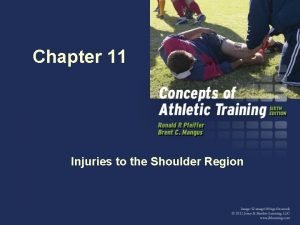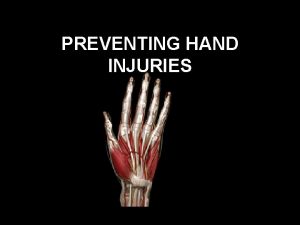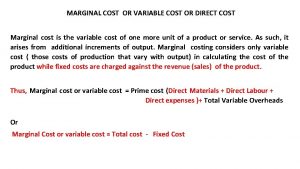2002 Direct cost of serious workplace injuries is






































- Slides: 38




2002 Direct cost of serious workplace injuries is $49. 6 B + Indirect cost of serious workplace injuries is estimated at $198. 4 B = Total estimated $248, 000, 000 cost of

ﻋﻠﻞ - ﻋﻀﻼﻧﻲ ﻣﺮﺗﺒﻂ ﺑﺎ ﻛﺎﺭ - ﺍﺧﺘ ﻻﺕﻼ ﺍﺳﻜﻠﺘﻲ • Repetition • Force • Awkward Posture • Static Posture • Contact Stress • Temperature Extremes • Vibration • Psycho Social


Lifting Injuries Aren’t Just Back Injuries Lifting results in: 30% of Shoulder WMSDs 43% of Back WMSDs 22% of Elbow WMSDs 13% of Hand/Wrist WMSDs WMSD = Work Related Muscular Skeletal Disorder Source: SHARP technical report No. 40 -6 -2002

Principles for reducing heavy lifting • Reduce the weight • Use mechanical assistance • Slide instead of lift • Team lifting

Reducing heavy lifting Reduce the weight of the load (plastic pallets) This example shows using lightweight plastic pallets, which weigh anywhere from 13 to 30 pounds for a standard 40” x 48” unit (the one in the picture is about 20 pounds). The traditional wooden 40” x 48” pallets weigh approximately 60 pounds. Costs: about $30 more per unit compared with wooden pallets Savings: Reduced shipping costs (empty pallets are nestable so more can be shipped back in one trailer) Reduced pallet repair and replacement costs (plastic is easier to clean when used in food processing) Fewer splinter/loose nail injuries

Reducing heavy lifting Use mechanical assistance This example shows a mobile pneumatic conveyor that can be used to move powdered and granular materials from any type of container (bags, barrels, bins, totes, etc. ) to a hopper or other part of a mixing system. The discharge (funnel shaped silver part at the top) is height adjustable.

Reducing heavy lifting Slide instead of lift This example is moving heavy duty batteries from one pallet to another when picking an order. Large truck and marine batteries can weigh up to 110 pounds (this one weighs about 75 pounds). By taking the time to set the order pallet to the same height as the storage pallet, the battery can be slid rather than lifted.

Reducing heavy lifting Team lifting works better on larger objects, such as the wallboard shown here. There is a labor cost involved with team lifting, although in some jobs there is always another person around out of necessity.

Reducing frequent lifting Use mechanical assistance The example shown is palletizing using a vacuum lift at a paper mill that produces bundles of grocery bags. The vacuum lift costs around $10, 000, but in this case it increases productivity by allowing one employee to palletize on more than one line at a time without getting fatigued. It also allows rotation of all employees through this job, since physical capacity isn’t a limiting factor.

Reducing frequent lifting Use mobile storage The example is a mobile parts rack from a gas and wood stove manufacturer. The metal parts can be fairly heavy (20 to 52 pounds). They go through several finishing and inspection steps before final assembly. By placing them on mobile racks, the parts can be moved from process to process with minimal lifting.

Principles for reducing duration of lifting • Rotate to other jobs • Use mechanical assistance

Reducing duration of lifting A link to a guide to job rotation can be found in the appendix at the end of this slide show Rotate to non-lifting tasks

Reducing awkward lifting - reaching Remove obstacles This shows lifting in and out of a tote with the side cut out. This can reduce the reach in many cases, although there will still be some awkward lifting. It’s one of the cheapest solutions, since it just requires the time to cut out the side of the tote. Bins with flip-down sides are also available, so that as they fill up the sides can be flipped-up into place to hold the boxes in place.

Reducing awkward lifting - reaching Slide objects closer This example shows an order picking using an inexpensive (~$15), metal hook, made in-house, to pull a box close to the edge of the shelf before lifting it. This works well for lighter items. Heavier items would need to be stored lower and slid closer using both hands.

Reducing awkward lifting - reaching - Reduce package size The drawings show the difference between lifting a large box with many items in it versus lifting a smaller box with fewer items in it. Not only will this reduce the weight, but it will also reduce the reach necessary to pick up the box. Costs to implement this idea will vary. If you’re the customer, you can request smaller packaging from the supplier and probably pay a little more per item due to their increased packaging costs.

Reducing awkward lifting - reaching - Team lifting can help to reduce the reach required to pick up a large object, since workers no longer need to place their hands at the object’s center of gravity (balance point). Remember, it’s not as effective as a piece of lifting equipment and an employee who is trained in how to use it properly.

Reducing awkward lifting - bending - Use mechanical assistance to raise the load This is a relatively common device used in industry – a scissor-lift cart. The height of the cart is adjusted hydraulically, in this case with a foot pedal, although powered adjustment mechanisms are also available. These carts cost about $1500. Workers can bring objects up to a better height for lifting, although the best use is to place the cart at the same height as the shelf or table the object is being transferred to or from, and then slide it over rather than lifting. Carts with rollers or roller balls are available to help make the sliding transfer easier.

Reducing awkward lifting - bending - Add handles This shows the difference in lifting posture between picking up a box from the bottom, and picking it up using handles near the top of the box. In this case, this product is shipped in a box with pre-cut handles, so it doesn’t cost anything to use them. There’s still some bending, but the box is now lifted from above the knees, rather than below them. There a couple of other good ideas in this photo as well. The box has been stacked on an empty pallet to raise it up a little (sometimes even raising something just 6” can make a difference in posture). The bottom pallet has also been designed with some toe space below the load deck to allow workers to get closer to the objects they’re lifting.

Reducing awkward lifting - bending - Avoid unnecessary lifting

Reducing awkward lifting – reaching above shoulders - Use mechanical assistance The device shown is a stacker, which is like a hand truck with a hand-cranked winch to move the platform up and down so that loads can be mechanically raised to the height they are shelved or removed from shelves. Stackers are available with lift heights up to 12 feet. A model with a foot brake to keep it from moving when sliding loads is around $780.

Reducing awkward lifting – reaching above shoulders Use mechanical assistance This example shows using a carton clamp on a forklift to split/combine two halves of a stack of bins, rather than un-stacking/stacking the top layers over shoulder height.

Reducing awkward lifting – reaching above shoulders - Use a rolling stair This is a simple solution, although safety is a concern when using anything like this. WISHA rules don’t allow going up and down ladders while carrying loads, so a rolling stair or “safety ladder” (50 degree slope or less) is required, or in this case a place to put the load down before going up or down the steps. The example is a cart with a stair attached (or a stair with a cart attached) and costs less than $400. The advantage is that the steps are always there, so no need to find a ladder, and they can set the load down as they go up and down the stairs.

Reducing awkward lifting – twisting - Use conveyors Conveyors such as this one are especially useful when changing directions, to help avoid twisting. This picture shows a gravity conveyor used to unload trucks in a shipping department. It allows the receiver to bring the boxes over to the computer to scan in the information and inventory the contents. The boxes can then be slid directly onto carts to be put away. Lifting only needs to occur twice, once to take the box from the truck and place it on the conveyor, and once to put the box away. This conveyor set up (gravity rollers) costs about $600



Tips to reduce risk of injury for lifting/lowering • • Weight Location Twisting Frequency







• http: //www 2. worksafebc. com/calculator/llc/li ftlower/Default. htm • http: //www 2. worksafebc. com/ppcc/default. h tm

 Yasuko namba beck weathers
Yasuko namba beck weathers Unit 15:8 providing first aid for cold exposure
Unit 15:8 providing first aid for cold exposure What is katniss’ opinion of thresh?
What is katniss’ opinion of thresh? Strickler spine and sport
Strickler spine and sport Westfield sports injuries
Westfield sports injuries Yorkhill minor injuries
Yorkhill minor injuries This technique requires two sturdy poles and a blanket
This technique requires two sturdy poles and a blanket Chapter 28 head and spine injuries
Chapter 28 head and spine injuries Chapter 21 caring for head and spine injuries
Chapter 21 caring for head and spine injuries Chapter 17:5 providing first aid for poisoning
Chapter 17:5 providing first aid for poisoning Injuries to muscles and bones chapter 15
Injuries to muscles and bones chapter 15 Chapter 14:1 using body mechanics
Chapter 14:1 using body mechanics Chapter 14 bleeding shock and soft tissue injuries
Chapter 14 bleeding shock and soft tissue injuries Chapter 13:2 preventing accidents and injuries
Chapter 13:2 preventing accidents and injuries Chapter 11 injuries to the shoulder region
Chapter 11 injuries to the shoulder region Chapter 11 assessment and evaluation of sports injuries
Chapter 11 assessment and evaluation of sports injuries Kristen wilson injuries
Kristen wilson injuries Pallet jack injuries
Pallet jack injuries An epidemiologic survey of roller skating injuries
An epidemiologic survey of roller skating injuries Climatic injuries
Climatic injuries Climatic injury
Climatic injury Glencoe health chapter 12
Glencoe health chapter 12 Chapter 4 preventing injuries through fitness
Chapter 4 preventing injuries through fitness Chapter 13 worksheet recognizing different sports injuries
Chapter 13 worksheet recognizing different sports injuries Chapter 4 basics of tissue injuries
Chapter 4 basics of tissue injuries Bo taoshi injuries
Bo taoshi injuries Miniscal cyst
Miniscal cyst Preventing hand injuries
Preventing hand injuries Battering intentional or unintentional
Battering intentional or unintentional How to make fake skin with vaseline and cornstarch
How to make fake skin with vaseline and cornstarch Poem about intentional injuries
Poem about intentional injuries Injuries first aid
Injuries first aid Injuries first aid
Injuries first aid Injuries first aid
Injuries first aid Characters of firearm injuries
Characters of firearm injuries Which osha document summarizes occupational injuries
Which osha document summarizes occupational injuries Sports injuries angus, on
Sports injuries angus, on Biomechanics of throwing a football
Biomechanics of throwing a football Atticus asks several times if anyone went for the .
Atticus asks several times if anyone went for the .






























































